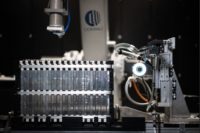SINGAPORE—A new automotive-grade flexible die-cut circuit (FDC) process developed by Ennovi gives engineers a sustainable way to mass-produce flexible circuits for low-voltage signals in electric vehicle battery cell contacting systems.
"Adopting the FDC capability for flexible circuits aligns with our vision to think outside the box in creating a sustainable battery value chain for EVs," says Gustavo Cibrian, energy systems product manager at Ennovi. "[This enables us] to offer battery manufacturers a design that balances their imperatives in terms of cost, time and performance.”
According to Cibrian, flexible printed circuits (FPC) are the most expensive component in the current collector assembly. He claims that FDC technology offers a more cost-effective and sustainable alternative, with fewer manufacturing procedures and faster continuous reel-to-reel production.
“Generally, FPCs are manufactured using a multi-stage, batch photolithography process to etch copper traces for the flexible circuit,” explains Cibrian. “This production process uses corrosive chemicals that dissolve the unwanted copper. In addition, it takes a lot of time and energy to extract the waste copper from the chemicals, making it challenging to effectively recycle.
“The die-cutting process allows for instant recycling of the copper, making it a more substance preference to chemical etching,” says Cibrian. “Compared with FPCs, which have a size limitation of 600 by 600 millimeters, FDCs boast no length restrictions as they are manufactured reel-to-reel. These results were confirmed through rigorous in-house dimension, thermal shock, trace resistance, temperature rise, insulation resistance and high-voltage testing.”




